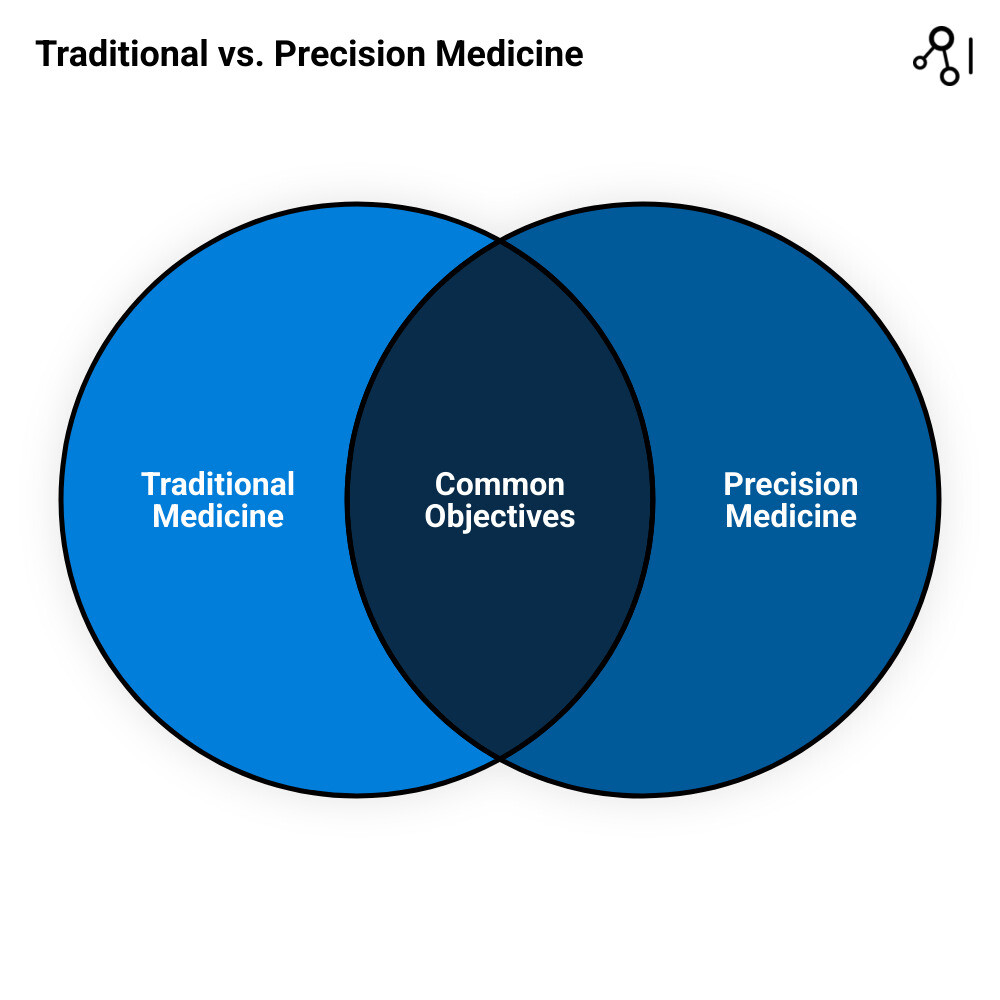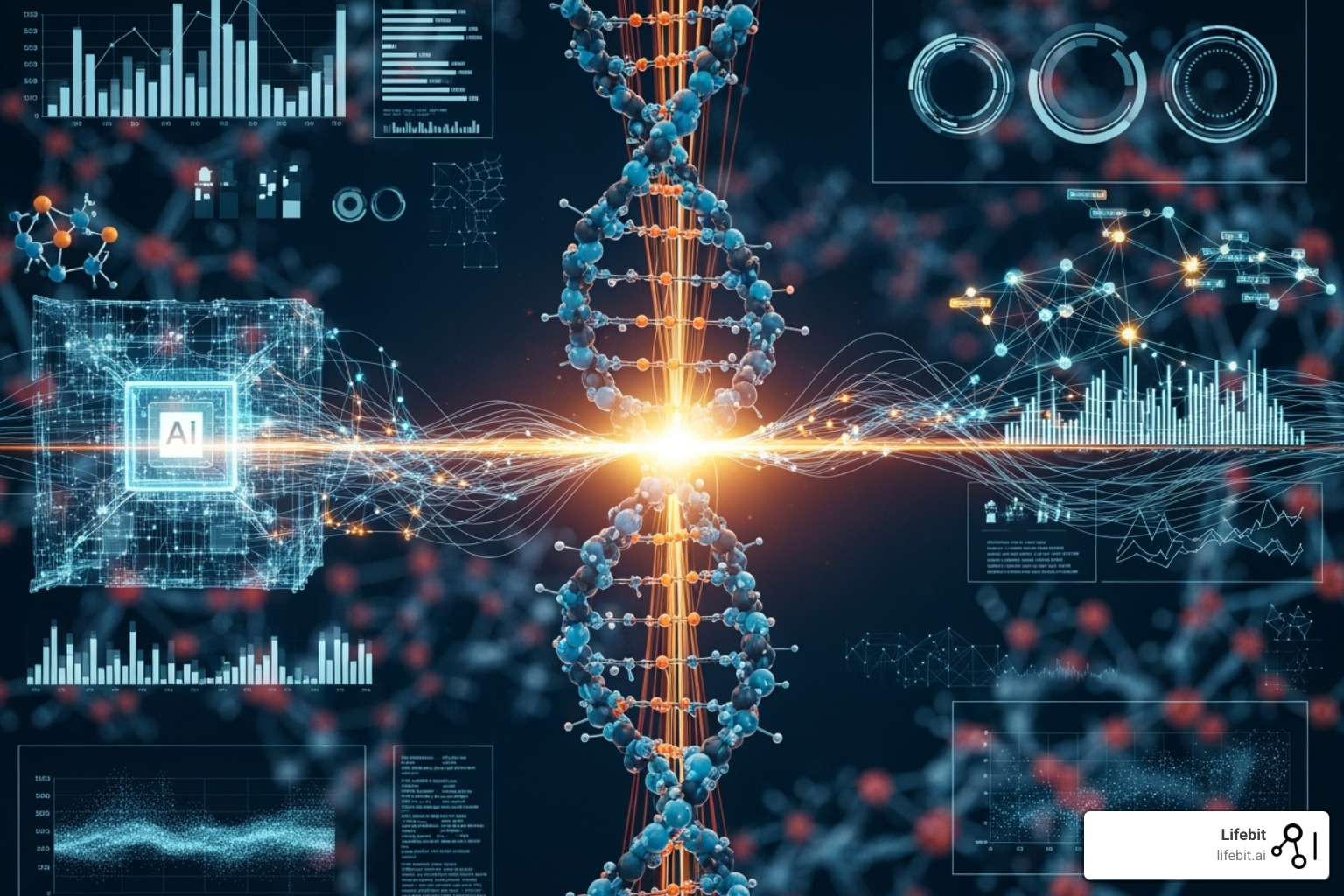The Future is Personal—Precision Medicine Trends You Can’t Ignore in 2025

Why 2025 is a Pivotal Year for Healthcare
Precision medicine trends 2025 are reshaping healthcare as we know it. Instead of the traditional one-size-fits-all approach, precision medicine tailors treatments to each person’s unique genes, environment, and lifestyle.
The top precision medicine trends for 2025 include:
- AI-powered drug findy – Using machine learning to predict molecular interactions and accelerate development
- Multi-omics integration – Combining genomics, proteomics, and metabolomics for complete patient profiles
- Cell and gene therapies scaling – CAR-T and gene editing moving beyond rare diseases
- Digital therapeutics – Software-based treatments for conditions like diabetes and anxiety
- Federated data analytics – Analyzing global datasets while preserving privacy and security
- Real-time genomics – Same-day sequencing results in clinical settings
- Wearable health tech – Continuous monitoring and personalized interventions
- Ethical AI frameworks – Ensuring transparent and equitable healthcare algorithms
2025 marks a tipping point where these technologies converge. We now have the computational power, data availability, and regulatory frameworks needed for widespread adoption. The numbers tell the story: the global precision medicine market is projected to reach USD 470.53 billion by 2034, growing at a 16.50% annual rate.
This isn’t just about better treatments – it’s about shifting from reactive sick care to proactive health management. Cancer patients are already seeing 30-40% better response rates with biomarker-matched therapies. Gene therapies that once seemed impossible are now treating sickle cell disease and inherited blindness.
As Maria Chatzou Dunford, CEO of Lifebit with over 15 years in computational biology and genomics, I’ve witnessed how federated data platforms are breaking down silos to accelerate precision medicine trends 2025. The challenge isn’t just scientific – it’s ensuring these breakthroughs reach everyone who needs them.

AI and Machine Learning: The New Engine of Drug Findy and Diagnosis

Picture this: instead of scientists spending years testing thousands of potential drugs, AI can predict which ones will work in just days. That’s not science fiction anymore – it’s one of the biggest precision medicine trends 2025 is bringing to life.
AI is completely changing how we find drugs. Traditional drug development used to be like looking for a needle in a haystack while blindfolded. Now, AI can predict molecular interactions with stunning accuracy, cutting development time from decades to years. Generative AI for de novo drug findy is creating entirely new compounds that have never existed before, designed specifically to target disease.
Take AlphaFold – Google’s AI system that can predict protein structures with incredible precision. This matters because knowing how proteins fold helps scientists understand how diseases work and design better treatments. It’s like having a blueprint for the building blocks of life.
In diagnostics, AI is becoming every doctor’s secret weapon. AI-powered systems can analyze medical images faster than any human radiologist, spotting early signs of cancer that might be missed. These systems don’t replace doctors – they make them superhuman at catching diseases early when they’re most treatable.
Clinical decision support systems are already helping doctors make better treatment choices. By analyzing massive amounts of patient data, AI can flag which patients are at risk and suggest the most effective treatments based on similar cases. It’s like having access to the collective wisdom of thousands of medical experts.
The numbers show just how big this revolution is becoming. The AI in precision medicine market is expected to hit USD 49.49 billion by 2034. That’s serious money backing a technology that’s already saving lives.
What excites me most is how AI is shortening the time from lab findy to patient treatment. When someone is fighting a rare disease, every day matters. AI is turning what used to be years-long diagnostic journeys into solutions that can be found in hours or days.
Multi-Omics Integration: Decoding Disease at Every Level

Think of traditional medicine as looking at a single snapshot of your health. Multi-omics integration is like watching a high-definition movie of everything happening in your body at once. It’s one of the most exciting precision medicine trends 2025 because it moves us far beyond just looking at genes.
Multi-omics combines data from genomics (your genes), transcriptomics (RNA activity), proteomics (proteins at work), metabolomics (chemical byproducts), epigenomics (how genes turn on and off), and microbiomics (your microscopic companions). This gives doctors a complete picture of what’s really driving health and disease.
The numbers show how quickly this field is growing. The multiomics market is projected to jump from USD 3.10 billion in 2025 to USD 12.65 billion by 2035, with a growth rate of 15.09% each year. That’s because researchers are finally seeing what happens when you connect all these biological dots.
Advanced Genomics and Next-Generation Sequencing (NGS)
Genomics remains the foundation of precision medicine, but it’s gotten incredibly sophisticated. Next-generation sequencing has transformed from a billion-dollar moonshot project to something that costs under $1,000 per genome. Of course, each human genome still creates about 100 gigabytes of data – that’s a lot of biological information to process!
Whole-genome sequencing (WGS) now helps doctors identify genetic variants that might predispose someone to disease, affect how they respond to medications, or drive cancer growth. It’s like having a detailed roadmap of someone’s biological tendencies.
Precision oncology shows how powerful this approach can be. Instead of giving everyone with the same type of cancer identical treatments, doctors can now tailor therapy based on each tumor’s unique molecular fingerprint. Australia’s MoST program demonstrates this beautifully – they’re finding actionable biomarkers in 75% of rare cancer patients, leading to much better outcomes.
Liquid biopsies are another game-changer. These simple blood tests can detect tiny fragments of tumor DNA floating in someone’s bloodstream. Minimal residual disease (MRD) tests can catch cancer coming back months before traditional scans would spot it, giving patients and doctors a huge head start on treatment.
Next-Gen Biomarkers and Microbiome Insights: Key precision medicine trends for 2025
While your genes provide the blueprint, proteomics and metabolomics show what’s actually happening in real-time. Proteins and metabolites are like the workers and tools in your cellular factory – they reveal how your body is responding to disease, treatment, or environmental changes.
AI is revolutionizing how we find these biomarkers. Instead of spending years in the lab, machine learning can rapidly analyze complex biological data to identify patterns that predict treatment response or disease risk. There’s even an AI tool called the FaceAge tool for predicting survival outcomes that can estimate biological age from facial features to help predict cancer outcomes.
Microbiome research is opening up entirely new avenues for health. Your gut microbiome – that busy community of trillions of microorganisms – does far more than help digest food. Research shows these microbes are actively shaping immune responses, influencing everything from vaccine effectiveness to mental health. This understanding is leading to microbiome-based therapeutics, where specially designed probiotics can produce beneficial compounds custom to individual needs.
The biomarkers market reflects this explosion of possibilities. It’s estimated to reach USD 198.58 billion by 2035, with omics technologies already capturing about 53% of the current market. These aren’t just numbers – they represent millions of patients who will receive more precise, effective treatments based on their unique biological signatures.
The Rise of Living Medicines: Cell and Gene Therapies Go Mainstream
Perhaps the most exciting of the precision medicine trends 2025 is watching cell and gene therapies (CGTs) transform from experimental treatments into mainstream medicine. These aren’t your typical pills or injections – they’re “living medicines” that use a patient’s own cells or genetic material to fight disease at its source.
Think of it this way: instead of giving someone a medication that might work, we’re essentially reprogramming their body to heal itself. It’s like upgrading your body’s software to fix bugs that cause disease.
CAR-T cell therapy has been leading this revolution, especially in blood cancers. Doctors take a patient’s immune cells, engineer them in the lab to become super-powered cancer fighters, then infuse them back into the patient. These engineered cells can hunt down and destroy cancer cells with remarkable precision. What’s really exciting is that we’re now seeing these therapies expand beyond blood cancers to tackle solid tumors and other challenging conditions.
The recent approval of Lifileucel for melanoma marks a significant milestone in this journey. This treatment uses tumor-infiltrating lymphocytes – immune cells that have already shown they can recognize the patient’s specific cancer.
Gene editing technologies like CRISPR, base editing, and prime editing are opening even more possibilities. These tools can literally rewrite faulty genetic code that causes inherited diseases. We’re not just treating symptoms anymore – we’re correcting the underlying genetic problems that cause conditions like sickle cell disease and other genetic disorders.
But here’s the challenge: manufacturing these highly personalized therapies isn’t simple. Each treatment is custom-made for one patient, which creates complex logistical puzzles. How do you scale something that’s inherently personalized?
The good news is that decentralized manufacturing and automated bioprocessing are making these therapies more accessible. Instead of having one massive facility trying to serve everyone, we’re seeing smaller, automated manufacturing units that can be deployed closer to patients. This approach reduces shipping time and costs while maintaining quality.
The numbers tell an incredible story of growth and potential. The global CGT market is projected to jump from USD 25.03 billion in 2025 to approximately USD 117.46 billion by 2034, expanding at an 18.7% annual growth rate.
This isn’t just about market size – it represents hope for millions of patients with conditions that were once considered untreatable. We’re moving into an era where genetic diseases, certain cancers, and other serious conditions might have cures rather than just treatments.
The Patient-Centric Shift: Digital Health and Personalized Diagnostics

Healthcare is finally catching up to the personalized experience we expect from our favorite apps and services. Instead of waiting until we’re sick to seek care, precision medicine trends 2025 are putting patients at the center of their health journey, giving them the tools to stay healthy and catch problems early.
This shift is huge. We’re talking about moving from a system where you visit the doctor when something’s wrong to one where your health is continuously monitored and optimized. It’s like having a personal health coach that never sleeps, constantly watching for changes and helping you make better decisions.
The numbers back up this change. The advanced diagnostics market is expected to reach USD 207 billion by 2033, growing at 10.09% annually. That’s a lot of investment flowing into tools that give patients and doctors better, faster insights.
Personalized Diagnostics and Continuous Monitoring
Remember when fitness trackers just counted steps? Those days are long gone. Today’s wearable technology has become incredibly sophisticated, acting as early warning systems for your health. Your smartwatch can now track your heart rhythm, monitor blood oxygen levels, and even detect signs of irregular heartbeat patterns that might signal serious conditions.
But it’s not just about the data – it’s about what happens with that information. Remote patient monitoring means your care team can spot concerning trends before you even feel symptoms. Imagine your device noticing subtle changes in your sleep patterns that could indicate the early stages of a health issue. Instead of waiting for your next appointment, your doctor gets an alert and can reach out proactively.
Point-of-care testing is bringing lab-quality diagnostics right to your bedside or local clinic. Need to know how your body will respond to a specific medication? Pharmacogenetic testing can now provide real-time analysis of your genetic profile, helping doctors choose the right drug and dosage on the spot. No more waiting days for results or playing guessing games with treatments.
The technology behind this is getting smarter too. AI-improved digital nucleic acid amplification tests are making these on-the-spot diagnostics faster and more accurate than ever before. It’s like having a mini laboratory wherever you need it most.
The Emergence of Digital Therapeutics (DTx) as a key precision medicine trend for 2025
Here’s where things get really interesting. Digital Therapeutics (DTx) aren’t just health apps you download on a whim – they’re software as a medical device, prescribed by doctors and backed by solid clinical evidence. Think of them as evidence-based interventions delivered through your phone or tablet.
These digital treatments are already making a real difference for people with diabetes, anxiety, and other chronic conditions. Instead of relying solely on medications, patients can access cognitive behavioral therapy apps that help manage depression or anxiety. Some DTx programs use game-based approaches to help children with ADHD improve their focus and attention.
What makes DTx so powerful is its scalability. While a traditional therapist can only see so many patients in a day, a well-designed digital therapeutic can help thousands of people simultaneously. This integration with care pathways means these tools work alongside your regular healthcare team, not instead of them.
The beauty of this patient-centric approach is that it puts you in control. You’re not just a passive recipient of healthcare – you’re an active participant with real-time insights and personalized tools to help you stay healthy. It’s healthcare that works with your life, not against it.
The Data Backbone: Powering the Top Precision Medicine Trends 2025
Behind every breakthrough in precision medicine trends 2025 lies something that might surprise you: massive amounts of data. We’re talking about truly staggering volumes – a single human genome takes up about 100 gigabytes of storage. Now imagine multiplying that by millions of patients, adding in their medical records, lab results, imaging data, and real-time monitoring from wearables. It’s like trying to organize the world’s largest library while it’s still being written.
This data explosion isn’t just a storage problem – it’s the foundation that makes personalized medicine possible. Every AI diagnosis, every targeted therapy, and every predictive model depends on having access to rich, diverse datasets. But here’s the catch: most of this precious information is locked away in separate systems that can’t talk to each other.
Building a Secure and Scalable Data Infrastructure
Picture this scenario: a researcher in London finds a genetic pattern that could help treat a rare disease, but the data they need to validate their findings is scattered across hospitals in Boston, Berlin, and Bangkok. Traditional approaches would require moving all that sensitive patient data to one location – a privacy nightmare that’s often impossible due to regulations.
Data silos have become one of healthcare’s biggest headaches. Patient information sits isolated in different hospitals, research institutions, and even countries. These systems often use different formats, standards, and definitions, creating interoperability challenges that slow down medical breakthroughs. It’s like having pieces of a life-saving puzzle scattered across the globe, with no easy way to put them together.
The solution lies in harmonization – creating common standards and formats that allow different systems to understand each other. Think of it as teaching all these isolated databases to speak the same language.
Federated analytics is changing everything by flipping the traditional model on its head. Instead of bringing data to the analysis, we bring the analysis to the data. This means sensitive patient information never leaves its secure home, while researchers can still derive insights from global datasets. It’s like having a team of translators who can work with documents in their original locations without ever making copies.
Ethical AI and Explainability: The Keys to Clinical Trust
As AI becomes the brain behind many medical decisions, we face what experts call the “black box problem.” Imagine if your doctor prescribed a treatment but couldn’t explain why – that’s essentially what happens with many AI systems. They can be incredibly accurate, but their reasoning remains mysterious.
Explainable AI (XAI) is working to solve this puzzle by making AI models more transparent and interpretable for clinicians. When an AI system recommends a specific cancer treatment or flags a patient as high-risk, doctors need to understand the reasoning behind that decision. Recent advances like research on quantum AI for cancer detection are promising, but only if medical professionals can trust and understand how they work.
Ensuring equity in AI is perhaps even more critical. Here’s a sobering fact: over 80% of genetic research has focused on people of European ancestry. This means AI algorithms trained on this data might not work as well for other populations, potentially widening health disparities instead of closing them.
The path forward requires avoiding bias in algorithms and actively working to include diverse datasets. We need to ensure that the benefits of precision medicine trends 2025 reach everyone, not just those who happen to match the demographics of existing research studies. Democratizing access to these powerful tools isn’t just good ethics – it’s essential for creating treatments that work for all of humanity.
Frequently Asked Questions about Precision Medicine Trends
As precision medicine trends 2025 continue to reshape healthcare, many people have questions about what this all means. Let’s tackle the most common ones.
What is the main goal of precision medicine?
The main goal is to provide the right treatment to the right patient at the right time. It moves beyond a one-size-fits-all model by tailoring prevention and treatment to an individual’s unique genes, environment, and lifestyle. Key benefits include identifying the most effective treatments, enabling earlier disease detection based on personal risk factors, and reducing adverse drug reactions through pharmacogenomics. It shifts the focus from reactive sick care to proactive health management, allowing for early intervention based on a person’s genetic predispositions.
How is precision medicine different from personalized medicine?
While often used interchangeably, there’s a subtle distinction. ‘Personalized medicine’ can imply a unique treatment created for a single individual. ‘Precision medicine’ is a more accurate term, focusing on classifying patients into subgroups based on shared genetic, environmental, or lifestyle factors. This allows for targeted therapies that are effective for specific populations. For example, a drug might be developed for lung cancer patients with a specific EGFR mutation. In practice, both terms describe the move away from a one-size-fits-all approach toward more targeted and effective healthcare.
What are the biggest challenges facing precision medicine in 2025?
Despite its promise, precision medicine faces several key problems. Data Integration: Healthcare data is often siloed in incompatible systems, making large-scale analysis difficult. Privacy and Security: Protecting sensitive genomic and health data is paramount. Regulatory Lag: Frameworks struggle to keep pace with rapid technological advancements like AI and gene editing. Cost and Access: High upfront costs for therapies and diagnostics, coupled with inconsistent insurance reimbursement, create significant barriers. Equity: There’s a major risk of widening health disparities, as most genetic research has focused on European populations, potentially leading to biased algorithms and treatments. Overcoming these challenges requires a concerted effort to standardize data, establish clear regulations, create sustainable payment models, and ensure research is inclusive of diverse populations. Federated analytics offers a path forward for the data challenges by enabling secure analysis without centralizing sensitive information.
Conclusion: The Future of Healthcare is Here, and It’s Personal
The convergence of the top precision medicine trends 2025 signals a fundamental change in healthcare. We are moving decisively away from a one-size-fits-all paradigm to a future where treatment is as unique as an individual’s biology. The synergy between AI-driven findy, multi-omics integration, and living medicines like cell and gene therapies is no longer theoretical—it’s being applied in clinics today, offering cures for previously untreatable conditions. This revolution is further accelerated by a patient-centric shift, where digital health tools and wearables empower individuals to take a proactive role in their own health management. At the core of this progress is data—secure, interoperable, and ethically managed. Federated data platforms are the critical infrastructure enabling global collaboration without compromising patient privacy, breaking down the silos that have long hindered medical progress. 2025 is not just another year; it represents a tipping point where these powerful trends mature from experimental concepts to essential components of our healthcare system. The technology is ready, the infrastructure is being built, and the demand for personalized care is clear. The future of medicine is here—a future that is proactive, predictive, and profoundly personal.



